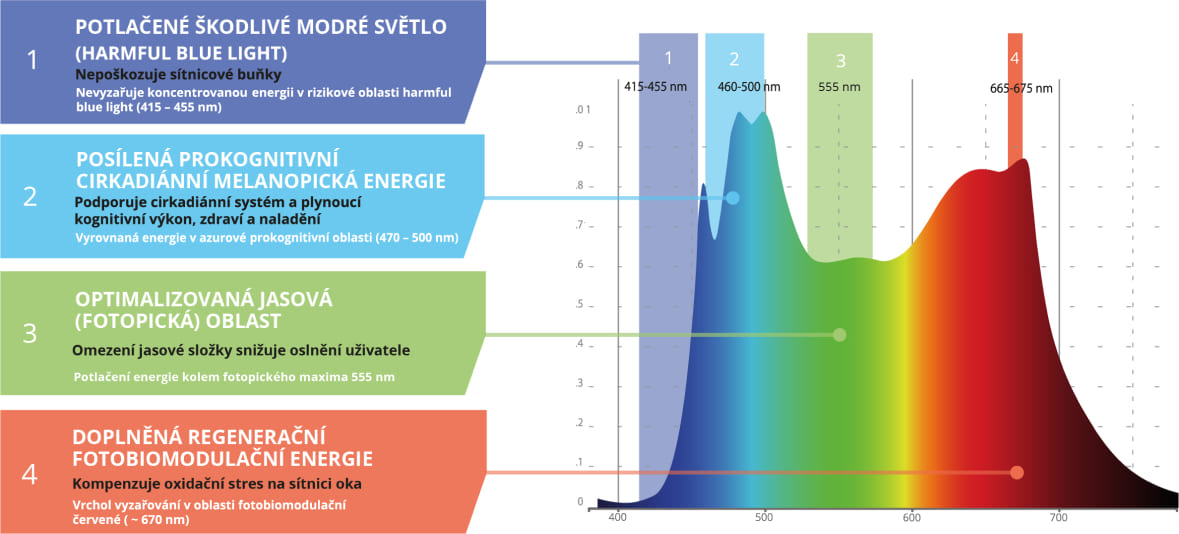Phototherapy and medicinal chronobiology
mental health centres hospitals spas specialised outpatient clinics
to prevent and treat mental disorders
Medical devices with proven efficacy

Light as a biological signal
Light is one of the key signals from the external environment that influences a number of physiological processes. In addition to enabling image forming vision through rods and cones in the retina, it is the most important synchroniser of the biological clock, which also directly affects areas of the brain that regulate mood, cognition and sleep. This so-called non-image forming ‘vision’ is mediated by a third type of photoreceptors in the retina, the intrinsically photosensitive retinal ganglion cells (ipRGC).
Phototherapy mechanism
The effects of phototherapy are mediated by way of the ipRGC cells, which form part of the optic nerve, and their outgrowths affect many areas of the brain. The dominant part leads to the hypothalamic region that controls circadian rhythms (suprachiasmatic nuclei, SCN). The human circadian clock runs with a genetically determined period that is typically slightly longer than the 24h length of the solar cycle, according to which social/conventional time is set. In healthy individuals, exposure to daylight during the day is sufficient to synchronise this internal time with the solar cycle through phase shifts, thus adjusting the length of its endogenous period. Disrupted synchronisation between the main pacemaker in the SCN and the peripheral clocks in other brain structures and peripheral organs or inefficient light synchronisation are common in many psychiatric and other diseases and may be the primary cause of some disorders. In these cases, phototherapy acts as an amplified synchronisation signal that modifies the phase, period and amplitude of circadian rhythms and, as a result, improves symptoms and accelerates the treatment of psychiatric diseases in particular. For people with disrupted circadian systems, the phase response curve is a useful tool to help determine the optimal time for phototherapy to secure the maximum expected effect. Since morning light is essential for the adjustment of the internal long period, morning hours are also the first choice for the application of the light intervention.
In addition to the synchronising effect of phototherapy on the circadian system, light also has a direct effect on brain structures that regulate cognition and mood. The ipRGC cells mainly act upon the perihabellar nucleus, connected to the lateral habenula, whose neuronal activity is significantly altered in patients with depression and other forms of psychiatric illness. Light also directly influences serotonergic, dopaminergic and noradrenergic neurotransmission through ipRGCs and their indirect action on the relevant neurons in the brainstem (via the lateral habenula and dorsomedial nucleus of the hypothalamus).
Higher efficiency, no negative effects on eyes
- Circadian rhythms
- Affective experience and mood
- Cognition
- Sleep
- Electrical activity of the brain
- Impact on vision and visual comfort
Read more about the efficiency verification in the certified methodology below.
Certified methodology of the National Institute of Mental Health of the Czech Republic
The certified methodology of the National Institute of Mental Health of the Czech Republic (NÚDZ ČR) (which can be downloaded here) may be used in the application of both of the phototherapeutic devices. They are intended for specialised physicians and health professionals who use phototherapy in the treatment of their patients.
![]()
The therapy can only be carried out on the advice and according to the instructions of a specialist doctor or therapist. Violation of these recommendations can cause adverse effects on the body.
Phototherapy products

Fototerapeutický pavilon
Pavilony vyrábíme a distribuujeme ve spolupráci s renomovanou českou společností Silentlab. Pavilon je velkoprostorové fototerapeutické...Více info
Fototerapeutický kufr Spectrasol
Jedná se o přenosné zařízení určené k fototerapii při hospitalizaci, ambulantní péči a při přechodu...Více info
The development and application methodology of the device were developed in cooperation with CTU UCEEB and NÚDZ under project No. FW02020025 funded with the support of the Czech Technology Agency and the Ministry of Industry and Trade of the Czech Republic as part of the TREND Programme






